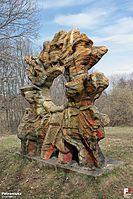Zofia Pociłowska
Zofia Pociłowska (also Zofia Pociłowska-Kann ; born March 3, 1920 in Charkow ; † May 8, 2019 ) was a Polish sculptor .
Life
Her family belonged to the Polish minority widespread in the western governorates of the Russian Tsarist Empire . The father was a blacksmith . After the Revolution tangled and the Russo-Polish war succeeded the family to relocate to Poland in 1920. Around 1930 the family lived in Warsaw, Zofia attended a private high school for girls. A degree in Polish studies that had just started was interrupted in 1939 by the German invasion of Poland and the occupation of Warsaw.
Like many of her patriotically oriented contemporaries, she joined the organized resistance and joined the Association for the Armed Struggle in January 1940 . She was used for courier services in Warsaw and in the eastern part of the General Government in Lublin , Zamość , Nakło and Siedlce . Due to a denunciation during her parents' visit, she was arrested by the Gestapo in March 1941 , taken to the Pawiak prison in Warsaw and later to the notorious Gestapo prison “Unter der Uhr” in Lublin. After numerous interrogations under torture, she was deported to the Ravensbrück women's concentration camp in September 1941 with a large transport of political prisoners . “ Return unwanted ” - that was her death sentence. With like-minded comrades she continued her conspiratorial work in the camp and was able to launch information about prison conditions, shootings and pseudo-medical experiments back home. These reports reached the Polish underground command and the government-in-exile in London .
Her artistic activity began in the camp. She carved small figures, including crucifixes and Polish national emblems. She wrote poems and scenic texts that were secretly circulated and recited in the camp on certain occasions, such as Christmas . After the liberation of the camp in May 1945, she returned to Warsaw and began studying sculpture at the Academy of Fine Arts in Warsaw under Professors Tadeusz Breyer and Marian Wnuk . Her diploma thesis in 1954 was a three meter high Beethoven monument. She was married to the Polish sculptor and painter Piotr Kann and has four daughters with him.
In the decades that followed, he created various large-format works dedicated to the memory of the victims of the war. This group includes the obelisk in the courtyard of the Pawiak memorial in Warsaw, the memorial at the Magdalenka execution site (near Warsaw) and a Pietà for the Polish memorial room in the former Ravensbrück concentration camp. Another group of large sculptures is dedicated to Polish history.
Despite this preoccupation with the shadows of the past, which is obvious from her biography, Zofia Pociłowska does not want to be committed to this topic. Elementary affirmation of life, the search for the "true and beautiful", is particularly expressed in her diverse small sculptures. This includes the heads and busts of their children, the figure of a pregnant woman, Romeo and Juliet , the origin of the earth, a head of Niobe , animal figures, blossoming flowers. She mainly uses ceramic and glass as material . She strives for a subtle expressiveness through furrowed surfaces.
The portraits of outstanding personalities, including an Old Testament "prophet", the bust of the father, Janusz Korczak , impressive heads of the Polish poets Bruno Schulz and Witkacy (SI Witkiewicz), both made of ceramic with wooden bark as a background, form a special strand in her work . On the fiftieth anniversary of the uprising in the Warsaw Ghetto , a cycle “In memory of the Polish Jews at the time of the Shoah” was created. She dedicated a poem of the same name to this topic.
Zofia Pociłowska made her debut at the All-Polish Exhibition of Young Sculpture in 1955 and has since been represented at numerous solo and collective exhibitions in Poland. Individual works have been shown abroad, for example in Nancy (1966), Paris and Vienna (1968), as well as in the Polish cultural institutes in Berlin ( GDR ), Bratislava , Budapest and Sofia . Recently representative exhibitions have taken place in the Lublin Castle Museum (2005) and in the house of the sculptor Warsaw (2010). The Wewelsburg Castle Museum followed with an exhibition in June 2013, making a larger selection of Zofia Pociłowska's work known in Germany for the first time.
Zofia Pociłowska died on May 8, 2019 in Warsaw .
Ceramic sculpture Sun in the Sculpture Park in Rusinowa
literature
- Janina Hunek (eds.), Dorota Kubacka, Barbara Oratowska: Zofia Pociłowska. Rzeźby. Catalog wystawy “Czas przemijalny” (catalog of the exhibition “Czas przemijalny”). Muzeum Lubelskie, Lublin 2005 (Polish).
- Andrea Genest (Ed.): So that the world knows ... Illegal documents from Polish prisoners from the Ravensbrück concentration camp (= research contributions and materials from the Brandenburg Memorial Foundation , vol. 14). Metropol, Berlin 2015, ISBN 978-3-86331-235-0 .
Web links
- A smuggling find from the concentration camp: Interview with Zofia Pociłowska . Retrieved December 29, 2013.
- You're different? An interactive online exhibition for young people , portrait of Zofia Pociłowskas by Inge Brouwer and Sarah Hagmann
- Exhibition report Wewelsburg
- detailed portrait on muzeumlubelskie.pl (Polish)
- Zofia Pocilowska at the Federal Agency for Civic Education
- Catalog of works on ipn.gov.pl
Individual evidence
- ↑ The Ravensbrück Memorial Mourns the loss of Zofia Pociłowska-Kann (1920-2019). In: stiftung-bg.de. Brandenburg Memorials Foundation , July 2, 2019, accessed on October 8, 2019.
| personal data | |
|---|---|
| SURNAME | Pociłowska, Zofia |
| ALTERNATIVE NAMES | Pociłowska-Kann, Zofia |
| BRIEF DESCRIPTION | Polish sculptor |
| DATE OF BIRTH | March 3, 1920 |
| PLACE OF BIRTH | Kharkov |
| DATE OF DEATH | May 8, 2019 |
| Place of death | Warsaw |



